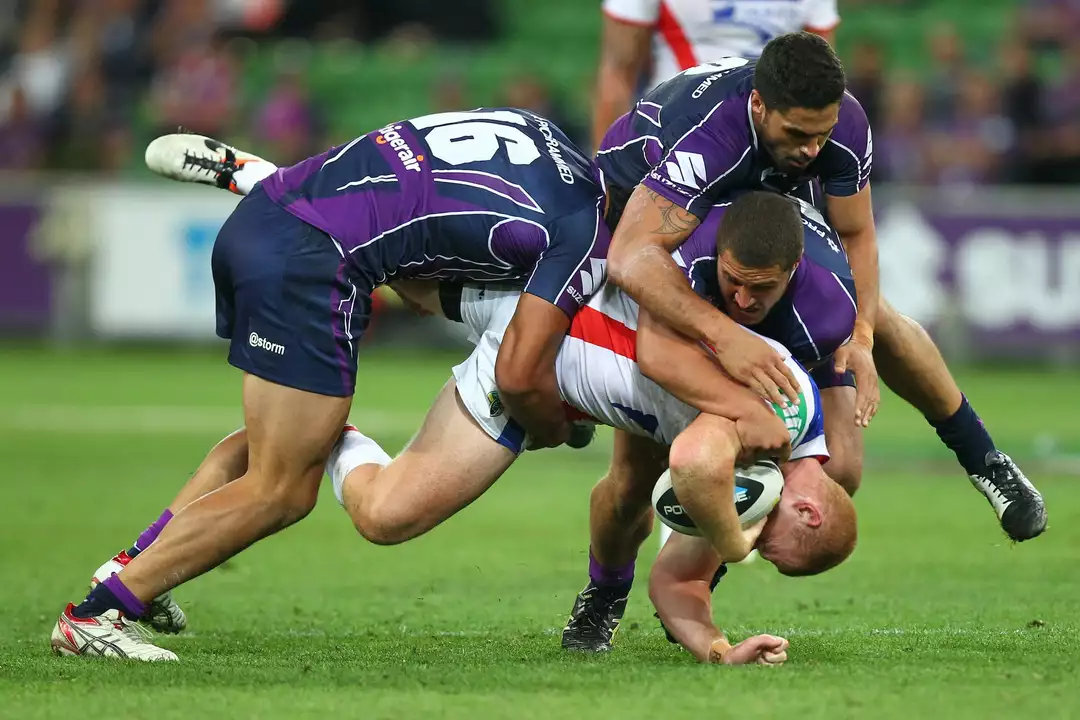Exploring the Role of the Referee in Rugby After a Tackle
Rugby is a thrilling sport that involves physical contact, speed, and agility. It's also a game of rules, and when it comes to tackling, the referee is an important figure on the field. After a tackle, the referee is responsible for evaluating the situation and determining if a penalty should be called.
So, what exactly happens after the ball carrier is tackled? It all starts with the referee assessing the situation. The referee must make sure that the tackle was legal and that no other player was involved in the tackle. If the referee finds that the tackle was illegal, he or she will blow the whistle and call a penalty on the tackler.
If the tackle was legal, the referee must still assess the situation. Depending on the outcome of the tackle, the referee may call a scrum or a lineout. A scrum is when the ball is put back into play and the players must form a scrum in order to win the ball. A lineout is when the ball is thrown in play by the referee and the players must form a line to try to win the ball.
The referee must also evaluate the player who was tackled. If the player is injured, the referee can stop the game and call for medical attention. If the player is not injured, the referee will signal for the game to continue.
After the tackle has been evaluated, the referee will then decide if any penalties should be called. Penalties can range from a yellow card for a minor infraction, to a red card for a major infraction. If a penalty is called, the offending player must leave the field and the team is penalized by having fewer players on the field.
The referee is an essential figure on the rugby field. After a tackle, the referee is responsible for assessing the situation and determining if a penalty should be called. The referee must evaluate the player who was tackled and decide if medical attention is needed. The referee must also decide if a scrum or lineout should be called, and if any penalties should be given.
Understanding the Laws of Rugby: What Happens After a Tackle?
Rugby is a full-contact sport that requires a certain level of physicality from its players. It is no surprise then that the game revolves around physical contact - particularly tackling. Tackling is an important element of rugby and one of the most exciting components of the game. But what exactly happens after a tackle has been made?
When a tackle is made, the ball carrier must release the ball and the tackle is considered complete. All other players must release their hold of the tackled player and move away so that a ruck can be formed. A ruck is a formation in which players from each team bind together and try to win possession of the ball. This is done by pushing their opponents back and utilizing the weight of their bodies. The team that has possession of the ball is said to have "rucked over" the ball and is allowed to retain it.
Once the ball has been rucked over, play resumes. The team that won possession of the ball is now allowed to keep it and move it down the field. If the team that won possession did not manage to move the ball far enough down the field, they must kick it to the opposition. The opposition then has the chance to counter-attack and take control of the ball. This is known as a "kick-off".
Rugby is a contact sport, and tackles are a necessary part of the game. Tackles must be completed in the correct manner in order to avoid any penalties. After a tackle has been completed, the ball carrier must release the ball and the opposing team must form a ruck to win possession. Once the ball has been rucked over, play resumes and the team that won possession can move it down the field. If they cannot move the ball far enough, they must kick it to the opposition and the opposition can then counter-attack. Understanding the laws of rugby is key to succeeding in the game.
Breaking Down the Different Phases of Play After a Tackle in Rugby
Tackling is one of the most fundamental aspects of rugby. When a player has possession of the ball, they can be tackled by an opposing player. Tackles are a crucial way to gain or defend ground. After a player is tackled, the game continues—but in what way? Let's break down the different phases of play that follow a tackle in rugby.
The Tackle
The tackle itself is when an opposing player brings down a ball carrier by grabbing them and stopping their progress. Tackles must be made below the shoulder and above the waist, and contact must be made with the shoulder, chest, or arms. The tackle must be completed with both arms around the ball carrier. If any of these conditions are not met, the tackle is illegal and a penalty may be awarded to the opposing team.
The Ruck
Once the tackle is complete, players from both teams can contest for the ball. This contest is known as a “ruck”. The ruck is formed when one or more players from each team bind together over the ball on the ground. The players try to gain control of the ball and push it back to their teammates. No players are allowed to handle the ball during a ruck, and they must stay on their feet and use their arms and feet to gain control of the ball.
The Maul
If the ball carrier is held up by one or more players of the same team after the tackle, then a maul is formed. A maul is similar to a ruck but the ball is not on the ground. Players from both teams bind together and attempt to gain control of the ball. The ball must be released from the maul within five seconds, or a penalty may be awarded.
The Scrum
If the ball is still in possession of the team that was in possession when the tackle occurred, a scrum is formed. A scrum is a way for the two teams to restart play after a minor infringement of the rules. The scrum consists of eight players from each team who bind together and push against each other in an attempt to gain control of the ball. The scrum-half passes the ball into the tunnel formed by the two teams, and the opposing team tries to regain possession.
The Lineout
If the ball goes out of bounds or a team kicks the ball out of play, a lineout is formed. The lineout is a way for the two teams to restart play without either team having an advantage over the other. Each team lines up five meters apart and the ball is thrown from the side line. The team not in possession of the ball at the time of the lineout then attempts to regain possession of the ball.
Tackling is one of the most important aspects of rugby, and understanding the different phases of play after a tackle can help players to better understand the game. By understanding the tackle, ruck, maul, scrum, and lineout, players can be better prepared to make the most of the situation and help their team gain an advantage.
Explaining the Impact of a Tackle on the Flow of the Game in Rugby
In rugby, the impact of a tackle on the game is immense. While it is a physical game, it is not simply a game of brute strength – the players’ agility and skill when tackling is key. A tackle is a defensive move which involves one or more players attempting to bring down an opposing player carrying the ball by grabbing and holding them. A successful tackle means that the ball carrier is brought to the ground, and the ball is then rucked or mauled.
The impact of a successful tackle is far-reaching. It halts the progress of the ball carrier, allowing the defending team time to regroup and reorganise. It also prevents the attacking team from moving the ball up the field, disrupting their momentum. This can be especially effective when the defending team is under pressure and a tackle can help them get back into the game.
The impact of a tackle on the game can also be psychological. When a team successfully completes a tackle, it can give them a huge confidence boost and spur them on to make more tackles. This can be particularly effective if they have been on the back foot for a while. Conversely, a successful tackle from the opposition can deflate a team’s morale and make them less likely to take risks.
The impact of a tackle is also felt in the scrum. When the ball carrier is successfully tackled, the ball must be rolled back and the scrum is formed. This allows the defensive team to regroup and reorganise again. It also allows the attacking team to set up their attacking plays, which can be crucial in deciding the outcome of the game.
Ultimately, the impact of a tackle on the flow of the game in rugby is immense. It can halt the progress of the ball carrier, disrupt the momentum of the attacking team and give the defending team a huge confidence boost. It also allows the teams to reorganise and reset their attacking plays. This makes it one of the most important aspects of the game, and one which all teams must be aware of.

